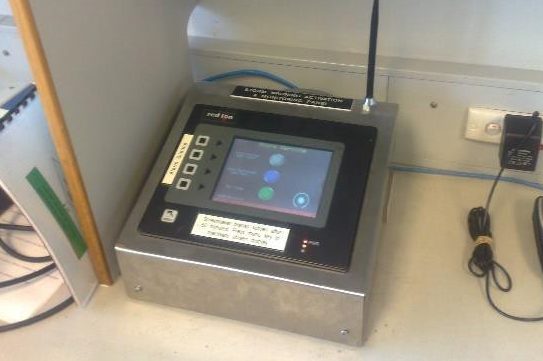Severe Storm Warning System
Severe storm activity is a danger to personnel, equipment and buildings at many facilities such as Airports, Shipping Ports, Mine Sites and other industries involving personnel and equipment being exposed to the elements.The Indratel Severe Storm Warning System is designed to enhance safety during these events. Over a period of time Indratel Australia has supplied and commissioned storm warning systems to all major Australian airports.
The system provides early warning to all operational areas of impending serve storm activity. This warning enables preparation to be made enhance safety and either eliminate or reduce the effects of this activity may have on the area.
Experience with Indratel Storm warning system
As a pilot I have had firsthand experience with the Indratel Airport storm warning system. It has been integral to the safety of airport staff, flight crew and passengers. The white light system was a notification that a storm was approaching the airfield and within a 10 Mile radius. This allowed us to start preparations to prioritise turnarounds so that the aircraft was ready to depart before the blue lights started flashing. The blue lights meant a total ramp shutdown, which means that there are no personal outside the aircraft that are allowed on the airport apron. A storm with observable lightening was now within 5 Miles of the aerodrome. For the safety of staff, the blue lights would stay on until the storm had moved outside of the 5 mile radius.
The system is important to allowing airport operations to maintain a high safety standard that is to be expected of the aviation industry.
Benefits to ground personnel
Ground support personnel operating around the aircraft and tarmac areas of any airfield are vulnerable to extreme weather situations. High winds, heavy rain and lightning places all personnel in the open in danger which can result in injury.
The Weather Warning system provides early warning to these personnel of an impending event which provides them the opportunity to secure all ground equipment and aircraft where required, cease operations and clear all personnel to safety prior to the weather event occurring.

Operation
The storm warning system central control & monitoring unit communicates via radio telemetry installed at multiple remote siren and strobe locations around the airport, to continuously monitor the status of these outstations, and control the sirens & strobes as required.
Note that the storm warning system is designed as a safety warning system (to warn staff of approaching thunderstorms and lightning activity); and does not detect lightning. The storm warning system is typically activated by operations staff (generally at the airport terminal operations centre) based on advice from Bureau of Meteorology (BOM).
Typical system operating philosophy (and stages) are as follows:
i) “Storm watch” – on days where the BOM has advised the airport of the high probability of thunderstorms, the airport will advise airlines and airport ground staff (through “toolbox” meetings, staff briefings, emails, etc) of the likelihood of operation of the storm warning system that day.
ii) “Storm warning” – if a thunderstorm encroaches within a 10Nm radius of the airport the storm warning system “Storm Warning” phase is activated from the central control & monitoring unit. This will activate a short duration audible alarm (siren) and operation of a white (clear) strobe at all storm warning siren/strobe panel locations around the airport.
The white (clear) strobe) will continue to operate until the storm warning system “All clear” or “Cease Operations” is activated. The storm warning phase is intended as an alert to airport staff (particularly those engaged in close contact with aircraft) to prepare for the possibility of a “Cease operations” if the storm continues to approach airport. This preparation might include expediting loading or unloading of aircraft (passengers, baggage & freight), fuelling, engineering, catering and other aircraft servicing e.g. water and waste.
iii) “Cease operations” – if the thunderstorm continues to approach, and encroaches within a 5Nm radius of the airport the storm warning system “Cease Operations” phase is activated from the central control & monitoring unit. This will activate continuous operation of the audible alarm (siren) and operation of a blue strobe at all storm warning siren/strobe panel locations around the airport. These will continue to operate until the storm warning system “All clear” or “Storm warning” is activated. During this phase all activities associated with close contact with aircraft are ceased.
iv) “All clear” – after the thunderstorm starts to recede from the airport vicinity, the storm warning system is selected to “storm warning” as the storm moves beyond the 5Nm radius, and then to “all clear” as the storm moves beyond the 10Nm radius. When the “All clear” is selected all storm warning system sirens & strobes will cease operation.
Note that it is not unusual for several phases of the storm warning system operation to be activated on days of severe thunderstorm activity i.e. being cycled between “Storm warning” & “Cease operations” as storm cells move in & out of the 10Nm & 5Nm radius of the airport.
Storm warning system control & monitoring units


The storm warning system central control & monitoring unit not only controls the remote siren and strobes, but also monitors the operating and condition status of these –allowing for appropriate proactive preventative maintenance and for alarm warning of failures, to maximise reliability of system.SMS alarms can also be generated to warn remote staff of system operation and/or failures.
Typical remote siren strobe panel installations





Airport – Storm warning system


